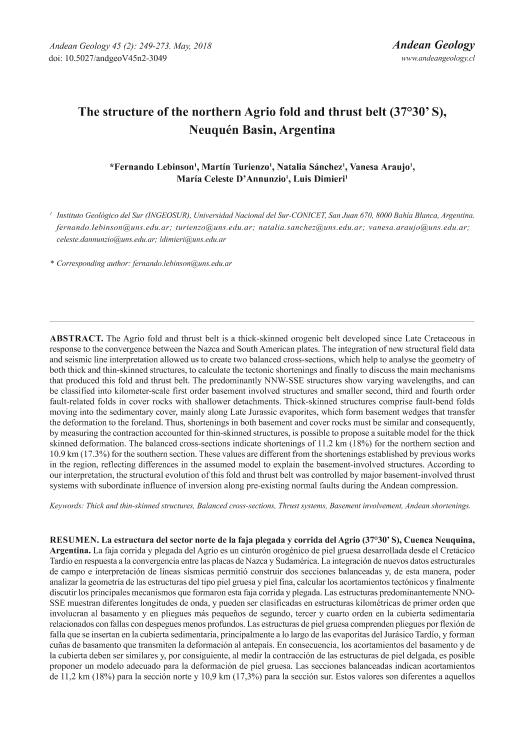Mostrar el registro sencillo del ítem
dc.contributor.author
Lebinson, Fernando Oscar

dc.contributor.author
Turienzo, Martin Miguel

dc.contributor.author
Sánchez, Natalia Paola

dc.contributor.author
Araujo, Vanesa Soledad

dc.contributor.author
D'annunzio, María Celeste

dc.contributor.author
Dimieri, Luis Vicente

dc.date.available
2019-09-18T14:26:32Z
dc.date.issued
2018-05
dc.identifier.citation
Lebinson, Fernando Oscar; Turienzo, Martin Miguel; Sánchez, Natalia Paola; Araujo, Vanesa Soledad; D'annunzio, María Celeste; et al.; The structure of the northern Agrio fold and thrust belt (37°30'S), Neuquén Basin, Argentina; Servicio Nacional de Geología y Minería; Andean Geology; 45; 2; 5-2018; 249-273
dc.identifier.issn
0718-7092
dc.identifier.uri
http://hdl.handle.net/11336/83841
dc.description.abstract
La faja corrida y plegada del Agrio es un cinturón orogénico de piel gruesa desarrollada desde el Cretácico Tardío en respuesta a la convergencia entre las placas de Nazca y Sudamérica. La integración de nuevos datos estructurales de campo e interpretación de líneas sísmicas permitió construir dos secciones balanceadas y, de esta manera, poder analizar la geometría de las estructuras del tipo piel gruesa y piel fina, calcular los acortamientos tectónicos y finalmente discutir los principales mecanismos que formaron esta faja corrida y plegada. Las estructuras predominantemente NNOSSE muestran diferentes longitudes de onda, y pueden ser clasificadas en estructuras kilométricas de primer orden que involucran al basamento y en pliegues más pequeños de segundo, tercer y cuarto orden en la cubierta sedimentaria relacionados con fallas con despegues menos profundos. Las estructuras de piel gruesa comprenden pliegues por flexión de falla que se insertan en la cubierta sedimentaria, principalmente a lo largo de las evaporitas del Jurásico Tardío, y forman cuñas de basamento que transmiten la deformación al antepaís. En consecuencia, los acortamientos del basamento y de la cubierta deben ser similares y, por consiguiente, al medir la contracción de las estructuras de piel delgada, es posible proponer un modelo adecuado para la deformación de piel gruesa. Las secciones balanceadas indican acortamientos de 11,2 km (18%) para la sección norte y 10,9 km (17,3%) para la sección sur. Estos valores son diferentes a aquellos previamente obtenidos en trabajos anteriores en la región, y reflejan principalmente las diferencias en los supuestos del modelo considerado para explicar las estructuras que involucran al basamento. De acuerdo a nuestra interpretación, la evolución estructural en este cinturón corrido y plegado estuvo controlada principalmente por sistemas de corrimientos que involucran al basamento, con una influencia subordinada de la inversión de fallas normales preexistentes durante la compresión andina.
dc.description.abstract
The Agrio fold and thrust belt is a thick-skinned orogenic belt developed since Late Cretaceous in response to the convergence between the Nazca and South American plates.The integration of new structural field data and seismic line interpretation allowed us to create two balanced cross-sections, which help to analyze the geometry of both thick and thin-skinned structures, to calculate the tectonic shortenings and finally to discuss the main mechanisms that produced this fold and thrust belt. The predominantly NNW-SSE structures show varying wavelengths and can be classified into kilometer-scale first order basement-involved structures and smaller second, third and fourth order fault-related folds in cover rocks with shallower detachments. Thick-skinned structures comprise fault-bend folds moving into the sedimentary cover, mainly along Late Jurassic evaporites, which form basement wedges that transfer the deformation to the foreland. Thus, shortenings in both basement and cover rocks must be similar and consequently, by measuring the contraction accounted for thin-skinned structures, is possible to propose a suitable model for the thick-skinned deformation. The balanced cross-sections indicate shortenings of 11.2 km (18%) for the northern section and 10.9 km (17.3%) for the southern section. These values are different from the shortenings established by previous works in the region, reflecting differences in the assumed model to explain the basement-involved structures. According to our interpretation, the structural evolution of this fold and thrust belt was controlled by major basement-involved thrust systems with a subordinate influence of inversion along pre-existing normal faults during the Andean compression.
dc.format
application/pdf
dc.language.iso
eng
dc.publisher
Servicio Nacional de Geología y Minería

dc.rights
info:eu-repo/semantics/openAccess
dc.rights.uri
https://creativecommons.org/licenses/by/2.5/ar/
dc.subject
Thick And Thin-Skinned Structures
dc.subject
Balanced Cross-Sections
dc.subject
Thrust Systems
dc.subject
Basement Involvement
dc.subject
Andean Shortenings
dc.subject.classification
Geociencias multidisciplinaria

dc.subject.classification
Ciencias de la Tierra y relacionadas con el Medio Ambiente

dc.subject.classification
CIENCIAS NATURALES Y EXACTAS

dc.title
The structure of the northern Agrio fold and thrust belt (37°30'S), Neuquén Basin, Argentina
dc.title
La estructura del sector norte de la faja plegada y corrida del Agrio (37°30’ S), Cuenca Neuquina, Argentina
dc.type
info:eu-repo/semantics/article
dc.type
info:ar-repo/semantics/artículo
dc.type
info:eu-repo/semantics/publishedVersion
dc.date.updated
2019-07-17T17:32:26Z
dc.identifier.eissn
0718-7106
dc.journal.volume
45
dc.journal.number
2
dc.journal.pagination
249-273
dc.journal.pais
Chile

dc.journal.ciudad
Santiago de Chile
dc.description.fil
Fil: Lebinson, Fernando Oscar. Consejo Nacional de Investigaciones Científicas y Técnicas. Centro Científico Tecnológico Conicet - Bahía Blanca. Instituto Geológico del Sur. Universidad Nacional del Sur. Departamento de Geología. Instituto Geológico del Sur; Argentina
dc.description.fil
Fil: Turienzo, Martin Miguel. Consejo Nacional de Investigaciones Científicas y Técnicas. Centro Científico Tecnológico Conicet - Bahía Blanca. Instituto Geológico del Sur. Universidad Nacional del Sur. Departamento de Geología. Instituto Geológico del Sur; Argentina
dc.description.fil
Fil: Sánchez, Natalia Paola. Consejo Nacional de Investigaciones Científicas y Técnicas. Centro Científico Tecnológico Conicet - Bahía Blanca. Instituto Geológico del Sur. Universidad Nacional del Sur. Departamento de Geología. Instituto Geológico del Sur; Argentina
dc.description.fil
Fil: Araujo, Vanesa Soledad. Consejo Nacional de Investigaciones Científicas y Técnicas. Centro Científico Tecnológico Conicet - Bahía Blanca. Instituto Geológico del Sur. Universidad Nacional del Sur. Departamento de Geología. Instituto Geológico del Sur; Argentina
dc.description.fil
Fil: D'annunzio, María Celeste. Consejo Nacional de Investigaciones Científicas y Técnicas. Centro Científico Tecnológico Conicet - Bahía Blanca. Instituto Geológico del Sur. Universidad Nacional del Sur. Departamento de Geología. Instituto Geológico del Sur; Argentina
dc.description.fil
Fil: Dimieri, Luis Vicente. Consejo Nacional de Investigaciones Científicas y Técnicas. Centro Científico Tecnológico Conicet - Bahía Blanca. Instituto Geológico del Sur. Universidad Nacional del Sur. Departamento de Geología. Instituto Geológico del Sur; Argentina
dc.journal.title
Andean Geology

dc.relation.alternativeid
info:eu-repo/semantics/altIdentifier/url/http://www.andeangeology.cl/index.php/revista1
Archivos asociados
